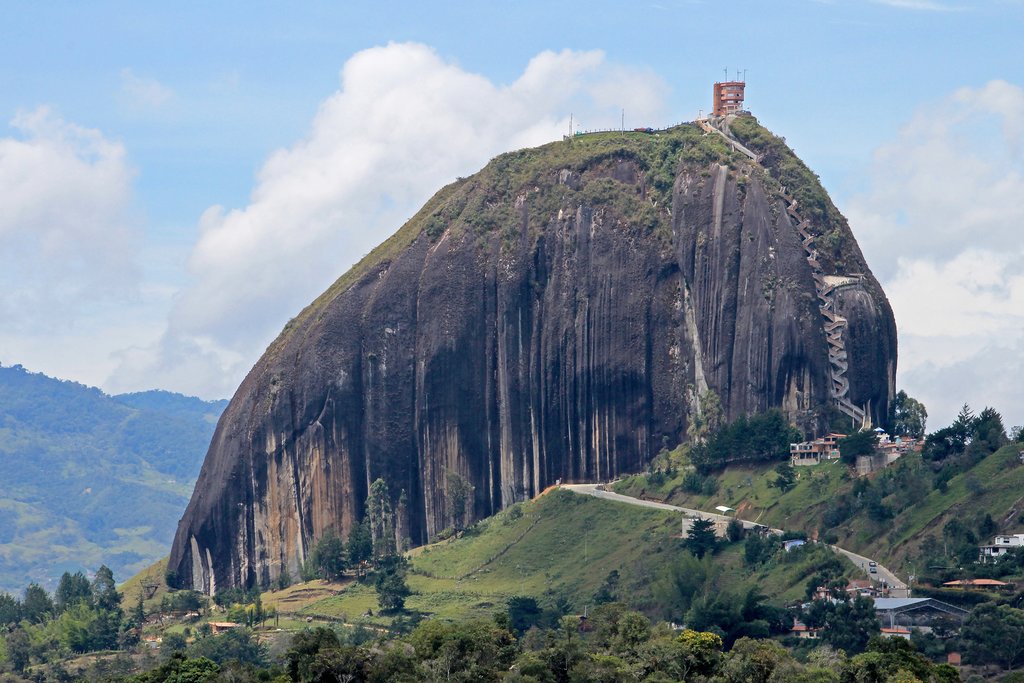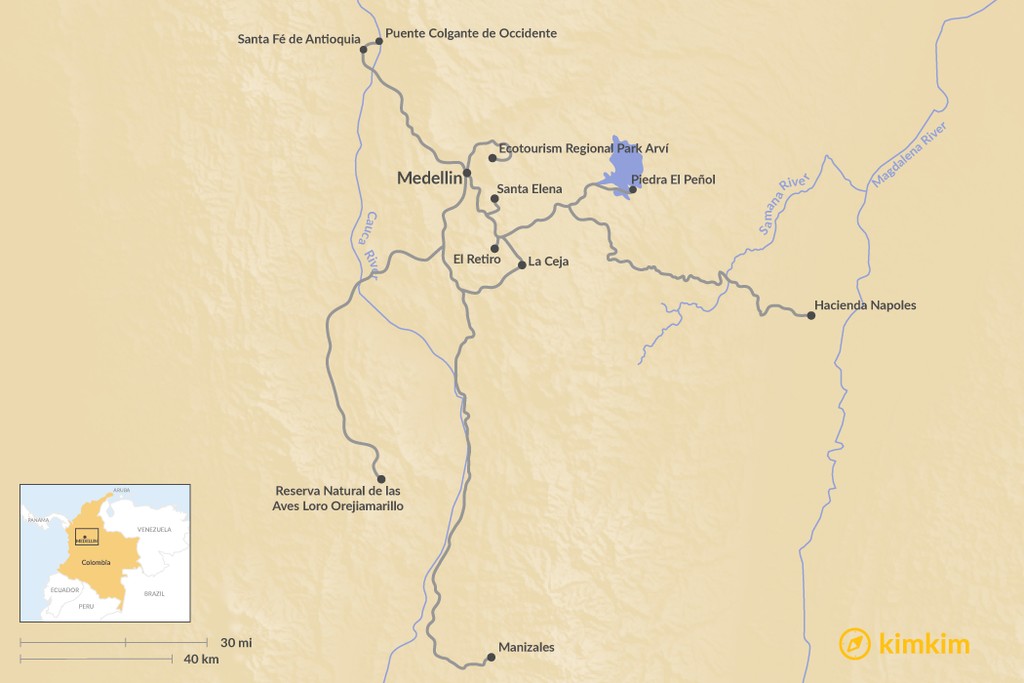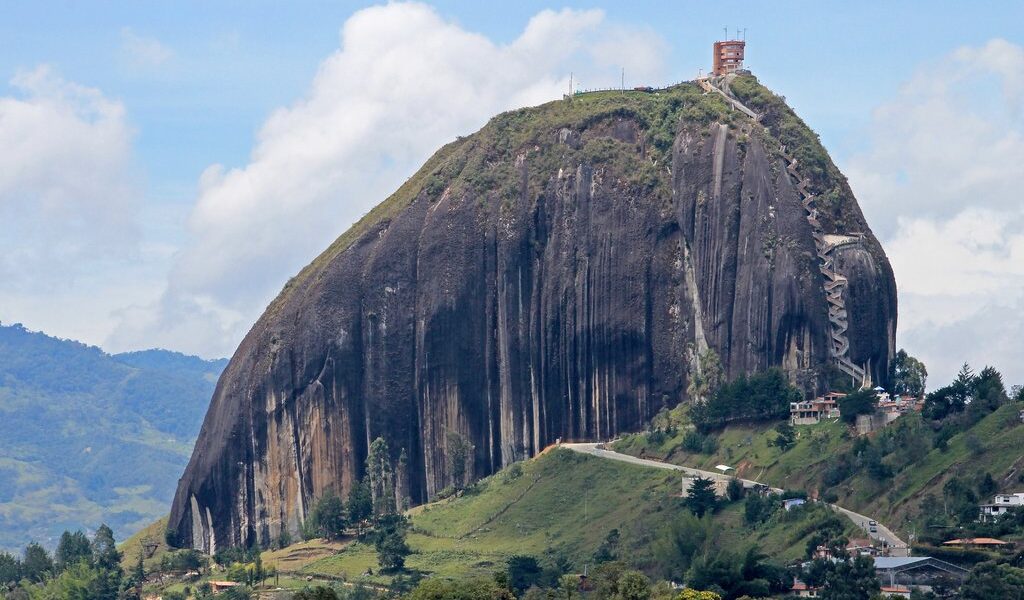
The mountains and valleys outside Medellín, in the department of Antioquia, offer a variety of excellent attractions and great day trips. These include the well-preserved colonial town of Santa Fé de Antioquia to the west, fragrant flower farms to the east, and the lush Coffee Triangle of Juan Valdez fame to the south. The following top 5 sites and activities make great add-ons to your city exploration.
## Discover the Wonders Around Medellín: A Journey Beyond the City
Medellín, a vibrant and cosmopolitan city, presents a striking contrast to the more traditional and closely-knit Antioquia region that envelops it. Venturing beyond the urban landscape reveals a tapestry of diverse experiences, from charming colonial towns nestled within the Cordilleras range to the verdant landscapes of Coffee Country, where age-old haciendas offer a glimpse into the world of coffee production and the opportunity to savor freshly ground, gourmet coffees.
The region surrounding Medellín is also renowned as an adventurer’s paradise, offering a plethora of exhilarating active day trips. From the thrill of rafting down rushing rivers to the breathtaking views from a paragliding flight and the invigorating challenge of hiking through stunning terrain, there’s something to satisfy every adventurous spirit. While reaching some of these destinations via public transport is possible, opting for a tour operator’s transportation often proves more efficient and convenient. Alternatively, renting a car provides the freedom to explore at your own pace, provided you possess reliable maps of the area.
## A Visit to Hacienda Napoles: Pablo Escobar’s Former Estate Transformed
Once the sprawling country estate of the notorious narco-terrorist Pablo Escobar, Hacienda Napoles has undergone a remarkable transformation into a family-oriented theme park, now managed by the local municipality. This transition signifies a conscious effort to gradually sever all ties to Escobar’s dark legacy. Spanning an impressive 8 square miles (20 square kilometers), the amusement park welcomes visitors through an arched gateway, prominently displaying the Piper airplane that Escobar used for his initial drug trafficking endeavors. The former mansion, for many years, served as the Museo Memorial, dedicated to recounting Escobar’s reprehensible actions. However, it tragically collapsed in 2015.
Today, the park’s primary attraction is an African-themed zoo, showcasing animals (and their offspring) – hippos, ostriches, and zebras – that were once part of Escobar’s private menagerie. In addition, a waterpark provides opportunities for aquatic fun, encouraging visitors to bring their swimsuits. The life-size concrete dinosaurs that Escobar commissioned remain on display as educational exhibits within Parque Jurásico. This unique park is situated approximately 90 miles (150 kilometers) northeast of Medellín, conveniently located along the Bogotá highway.
## Embalse del Peñol: Exploring a Scenic Reservoir
Considered by many to be Colombia’s most picturesque man-made creation, the Embalse del Peñol reservoir came into existence following the completion of a dam in 1978 within the Cordillera Central. This engineering marvel supplies a significant portion of Colombia’s electricity, accounting for approximately one-third of the nation’s power needs. The reservoir’s landscape is characterized by numerous isles, pristine white-sand beaches, and captivating peninsulas that extend into the jade-colored waters. Its undeniable beauty makes it a truly magnificent sight.
To fully appreciate the reservoir’s splendor, a visit to the summit of the Piedra El Peñol is highly recommended. This colossal granite monolith bears a striking resemblance to Rio de Janeiro’s iconic Sugarloaf Mountain. Ascending a 649-step staircase, which winds its way through a fissure in the dome, leads to a platform positioned 656 feet (200 meters) above the base. From this vantage point, panoramic views of the surrounding landscape unfold. The vibrant lakeside town of Guatapé, adorned with its tropical colors, stands as one of Colombia’s most charming colonial villages. Many of the homes feature zócalos, the extended lower third of the exterior walls, which are embellished with bas-relief depictions of village life, providing a glimpse into the local culture and history.
## Santa Fé de Antioquia: A Journey Through Historic Streets
A mere one-hour drive west of Medellín transports you to the enchanting pueblo of Santa Fé de Antioquia, a journey that feels like stepping into another world. Founded in 1541, Santa Fé de Antioquia served as the original capital of the Antioquia province until Medellín assumed the role in 1826. Since then, time seems to have slowed down in this remarkably well-preserved town. Narrow cobblestone streets wind through the heart of Santa Fé de Antioquia, lined with beautifully maintained Spanish architecture, all converging on the central Plaza Mayor.
The Catedral Basilica de la Inmaculada Concepción stands as the most significant among Santa Fé’s numerous ecclesiastical treasures, showcasing the town’s rich religious heritage. During the day, the town exudes a peaceful ambiance, but as evening descends, it awakens with vibrant energy. Bars clustered around Plazuela de la Chincha beckon night owls seeking entertainment. To complete your experience, be sure to hop aboard a moto ratón (literally, “mouse motorcycle”), a small tricycle taxi, for the 2-mile (3-kilometer) journey to Puente Colgante de Occidente. This photogenic suspension bridge spans the Río Cauca, offering stunning views and a unique perspective of the surrounding landscape.
## The Zona Cafetera: Immerse Yourself in the World of Coffee
Embarking on an early start, a day trip to Colombia’s renowned coffee-growing region, the Zona Cafetera, promises a return to Medellín in time to enjoy the city’s nightlife. This region has earned its place as a UNESCO World Heritage Site, recognized for its centuries-old haciendas, which are often accessed by WWII-era Willys Jeeps and colorful chivas that traverse the country lanes.
To maximize your experience, concentrate your exploration around Manizales, situated 120 miles (190 kilometers) south of Medellín. Manizales represents the northernmost of the three cities that constitute the Eje Cafetero, or “Coffee Axis,” making it the closest to Medellín. This ridgetop university town occupies steep hillsides, meticulously cultivated with coffee bushes. A visit to Hacienda Venecia, located west of town, offers guided tours of the coffee estate, and visitors can even choose to spend the night within the hacienda’s charming accommodations. In close proximity lies Reserva Forestal Nacional Río Blanco, recognized as one of the world’s premier destinations for birdwatching enthusiasts.
## South of Medellín: Discover the Aromatic Flower Farms
Embark on a captivating day-long excursion into the mountains immediately east of Medellín. The journey unveils a landscape dotted with numerous silliteras, or flower farms, where roses and other blooms are cultivated for export. Colombia plays a pivotal role in the global flower industry, supplying two-thirds of the USA’s imported cut roses and other flowers, representing a significant $1 billion a year industry. The country ranks second only to the Netherlands as the world’s largest flower supplier.
Carretera 35 Este ascends from the city towards Santa Elena, surrounded by fields ablaze with vibrant colors to the south, where the majority of the silliteras are located. The Corporación de Silliteros de Santa Elena provides a comprehensive list of farms that welcome visitors. Several historic pueblos also warrant exploration, including La Ceja, boasting a beautiful main plaza. Equally charming is El Retiro, a hub for crafts and rustic furniture workshops, and home to the Iglesia de Nuestra Señora de Chiquinquirá, which houses a magnificent baroque gilt altar.
## Parque Arví: A Haven for Outdoor Activities
Escape the urban hustle and bustle and embrace the tranquility of the mountain plateau situated immediately northeast of Medellín. This is the perfect setting to revel in the freedom and adrenaline rush of mountain biking or hiking amidst the cool cloud forest of Ecotourism Regional Park Arví. Dedicated to safeguarding the Medellín watershed, the park encompasses 4,352 acres (1,761 hectares) at an elevation ranging from 7,218 to 8,530 feet (2,200 to 2,600 meters). Eleven trails, some cobbled and predating the Spanish colonial era, meander through the forest, where mists often dance through the treetops.
Tour operators offer exhilarating mountain bike trips departing from the pueblo of Guarne. Alternatively, you can rent a bike in Medellín and take the Line K cable car from Acevedo Metrocable Station to Santo Domingo, followed by a transfer to Line L for Arví. The tram conveniently deposits you near the high-tech Environmental & Cultural Center, which features an amphitheater, a food court, and a market showcasing produce and artisanal crafts. Within the Comfama section, an adventure park awaits, offering zip-lines and vertical tree-scaling activities. The park is open from Tuesday to Sunday, from 9 am to 6 pm.
## The Yellow-Eared Parrot Reserve: A Birdwatcher’s Paradise
Bird enthusiasts are in for a treat at Reserva Natural de las Aves Loro Orejiamarillo, situated near Jardín, approximately a four-hour drive southwest of Medellín. This rain-soaked, cloud-shrouded 465-acre (188-hectare) reserve was established in 2006 with the specific aim of protecting the habitat of the endemic wax palm and the critically endangered Yellow-eared parrot.
The decline in wax palms (Ceroxylon quiduiense), Colombia’s national tree, during past decades nearly led to the extinction of the parrot population, which relies on these trees for nesting. Once reduced to a mere 80 birds, the population has rebounded to over 1,000 thanks to comprehensive education programs, the installation of nesting boxes, and the creation of the reserve. The optimal times to spot these remarkable birds are during the early morning and late afternoon hours.

B-396

